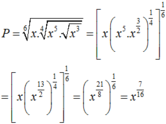x.x5=1. Tìm x

Những câu hỏi liên quan
Cho biểu thức
P
x
.
x
5
.
x
3
4
6
với x0. Mệnh đề nào dưới đây đúng A.
P
x
47
48...
Đọc tiếp
Cho biểu thức P = x . x 5 . x 3 4 6 với x>0. Mệnh đề nào dưới đây đúng
A. P = x 47 48
B. P = x 15 16
C. P = x 7 16
D. P = x 5 42
Cho biểu thức
P
x
.
x
5
.
x
3
4
6
với...
Đọc tiếp
Cho biểu thức P = x . x 5 . x 3 4 6 với x > 0 . Mệnh đề nào dưới đây đúng?
![]()
![]()
![]()
![]()
Bài 1: Viết gọn bằng cách dùng lũy thừa a) 3.5.15.9 b) 10.100.1000 c) 2.x.2.x.2.x b) a3.a6.a9 b) x2.x.x5.x7.x8 c) 34.44 d)23.84
Đọc tiếp
Bài 1: Viết gọn bằng cách dùng lũy thừa
a) 3.5.15.9 b) 10.100.1000 c) 2.x.2.x.2.x
b) a3.a6.a9 b) x2.x.x5.x7.x8 c) 34.44 d)23.84
a) 3.5.15.9 = 3.5.5.3.3.3 = 34.52
b) 10.100.1000 = 10.10.10.10.10.10 = 106
c) 2.x.2.x.2.x = 23.x3
d) a3.a6.a9 = a3+6+9 = a18
e) x2.x.x5.x7.x8 = x2+1+5+7+8 = x23
f) 34.44 = (3.4)4 = 124
g) 23.84 = 23 . (23)4 = 23.212 = 215
Đúng 1
Bình luận (0)
a: \(=15^2\cdot3^2=45^2\)
b: \(=10\cdot10^2\cdot10^3=10^6\)
c: \(=\left(2x\right)^3=8x^3\)
b: \(=a^{3+6+9}=a^{18}\)
d: \(=x^{2+1+5+7+8}=x^{23}\)
Đúng 0
Bình luận (0)
Viết kết quả phép tính dưới dạng một lũy thừa: x.x5
(Lưu ý trong câu này x là cơ số và x1 = x)
x.x5 = x1.x5 = x1+5 = x6
Đúng 0
Bình luận (0)
Chọn câu đúng:a, 1000
10
2
b,
102
0
0
c,
x
.
x
5
x
5
d,
2
7
:
2
4...
Đọc tiếp
Chọn câu đúng:
a, 1000 = 10 2
b, 102 0 = 0
c, x . x 5 = x 5
d, 2 7 : 2 4 = 2 3
a, Cho `0<x<25`
Tìm GTLN:`(80-2x)(50-2x)x`
b, `0<x<2`. Tìm GTLN: `5x(2-x)`
c, `x≥2`. Tìm GTLN: `x + 1/x`
d, Cho `x,y>0, x+y≤1`. TÌm GTNN: `x + y + 1/x + 1/y`
d. Áp dụng BĐT Caushy Schwartz ta có:
\(x+y+\dfrac{1}{x}+\dfrac{1}{y}\le x+y+\dfrac{\left(1+1\right)^2}{x+y}=x+y+\dfrac{4}{x+y}\le1+\dfrac{4}{1}=5\)
-Dấu bằng xảy ra \(\Leftrightarrow x=y=\dfrac{1}{2}\)
Đúng 1
Bình luận (5)
c. Bạn kiểm tra lại đề nhé.
b. \(5x\left(2-x\right)=-5x\left(x-2\right)=-5\left(x^2-2x\right)=-5\left(x^2-2x+1-1\right)=-5\left(x-1\right)^2+5\le5\)-Dấu bằng xảy ra \(\Leftrightarrow x=1\)
Đúng 1
Bình luận (1)
a.
\(\left(80-2x\right)\left(50-2x\right)x=\dfrac{2}{3}\left(40-x\right)\left(50-2x\right)3x\le\dfrac{2}{3}\left(\dfrac{40-x+50-2x+3x}{3}\right)^3=18000\)
Dấu "=" xảy ra khi \(40-x=50-2x=3x\Leftrightarrow x=10\)
b.
\(5x\left(2-x\right)=5.x\left(2-x\right)\le\dfrac{5}{4}\left(x+2-x\right)^2=5\)
Dấu "=" xảy ra khi \(x=2-x\Rightarrow x=1\)
c.
Biểu thức này chỉ có min, ko có max
d.
\(x+y\le1\Rightarrow-\left(x+y\right)\ge-1\)
\(x+y+\dfrac{1}{x}+\dfrac{1}{y}=\left(4x+\dfrac{1}{x}\right)+\left(4y+\dfrac{1}{y}\right)-3\left(x+y\right)\ge2\sqrt{\dfrac{4x}{x}}+2\sqrt{\dfrac{4y}{y}}-3.1=5\)
Dấu "=" xảy ra khi \(x=y=\dfrac{1}{2}\)
Đúng 0
Bình luận (0)
b3 tìm x
1. A = \(\dfrac{-2}{x-1}\) tìm x để A > 0 với x ≥ 0 , x ≠1
2. A = \(\dfrac{\sqrt{x}+1}{\sqrt{x}-1}\) tìm x để A < 1 với x ≥ 0, x≠1
1: Để A>0 thì x-1<0
hay x<1
Kết hợp ĐKXĐ, ta được: \(0\le x< 1\)
Đúng 0
Bình luận (0)
1) Để A > 0 thì:
\(x-1< 0\Leftrightarrow x< 1\)
\(\Rightarrow0\le x< 1\) và \(x\ne1\)
2) \(A=\dfrac{\sqrt{x}+1}{\sqrt{x}-1}=1+\dfrac{2}{\sqrt{x}-1}\)
Để A<1 thì \(\dfrac{2}{\sqrt{x}-1}< 0\)
\(\Rightarrow\sqrt{x}-1< 0\Leftrightarrow\sqrt{x}< 1\)
Mà x\(\ge0,x\ne1\)
\(\Rightarrow0\le x< 1\)
Đúng 1
Bình luận (0)
Bài 2:
Để A<1 thì A-1<0
\(\Leftrightarrow\dfrac{\sqrt{x}+1-\sqrt{x}+1}{\sqrt{x}-1}< 0\)
\(\Leftrightarrow\dfrac{2}{\sqrt{x}-1}< 0\)
\(\Leftrightarrow\sqrt{x}-1< 0\)
hay x<1
Kết hợp ĐKXĐ, ta được: \(0\le x< 1\)
Đúng 0
Bình luận (0)
cho p= [(3/x-1)+(1/ căn x +1)] : 1/căn x +1
a) tìm dkxd, rút gọn p
b) tìm giá trị p khi x=3+ 2 căn 2
c) tìm giá trị của x để p<0
d) tìm gtnn của M= (x+12/ căn x -1)*1/p
A=\(\dfrac{x}{x-4}+\dfrac{1}{\sqrt{x}-2}+\dfrac{1}{\sqrt{x}+2}\)
a) Rút gọn A ( tìm đkxđ )
b)Tìm A khi x = 36
c)Tìm x để A= -1/3
d) Tìm x để A>0
e)Tìm x thuộc Z để A thuộc Z
ĐKXĐ: \(x\ge0;x\ne4\)
\(A=\dfrac{x}{\left(\sqrt{x}-2\right)\left(\sqrt{x}+2\right)}+\dfrac{\sqrt{x}+2}{\left(\sqrt{x}+2\right)\left(\sqrt{x}-2\right)}+\dfrac{\sqrt{x}-2}{\left(\sqrt{x}-2\right)\left(\sqrt{x}+2\right)}\)
\(=\dfrac{x+2\sqrt{x}}{\left(\sqrt{x}-2\right)\left(\sqrt{x}+2\right)}=\dfrac{\sqrt{x}\left(\sqrt{x}+2\right)}{\left(\sqrt{x}-2\right)\left(\sqrt{x}+2\right)}=\dfrac{\sqrt{x}}{\sqrt{x}-2}\)
b. \(x=36\Rightarrow A=\dfrac{\sqrt{36}}{\sqrt{36}-2}=\dfrac{6}{6-2}=\dfrac{3}{2}\)
c. \(A=-\dfrac{1}{3}\Rightarrow\dfrac{\sqrt{x}}{\sqrt{x}-2}=-\dfrac{1}{3}\Rightarrow3\sqrt{x}=2-\sqrt{x}\)
\(\Rightarrow4\sqrt{x}=2\Rightarrow\sqrt{x}=\dfrac{1}{2}\Rightarrow x=\dfrac{1}{4}\)
d. \(A>0\Rightarrow\dfrac{\sqrt{x}}{\sqrt{x}-2}>0\Rightarrow\sqrt{x}-2>0\Rightarrow x>4\)
e. \(A=\dfrac{\sqrt{x}-2+2}{\sqrt{x}-2}=1+\dfrac{2}{\sqrt{x}-2}\in Z\Rightarrow\sqrt{x}-2=Ư\left(2\right)\)
\(\Rightarrow\sqrt{x}-2=\left\{-2;-1;1;2\right\}\)
\(\Rightarrow\sqrt{x}=\left\{0;1;3;4\right\}\Rightarrow x=\left\{0;1;9;16\right\}\)
Đúng 0
Bình luận (0)
a: Ta có: \(A=\dfrac{x}{x-4}+\dfrac{1}{\sqrt{x}-2}+\dfrac{1}{\sqrt{x}+2}\)
\(=\dfrac{x+\sqrt{x}+2+\sqrt{x}-2}{\left(\sqrt{x}-2\right)\left(\sqrt{x}+2\right)}\)
\(=\dfrac{\sqrt{x}}{\sqrt{x}-2}\)
b: Thay x=36 vào A, ta được:
\(A=\dfrac{6}{6-2}=\dfrac{6}{4}=\dfrac{3}{2}\)
c: Để \(A=-\dfrac{1}{3}\) thì \(3\sqrt{x}=-\sqrt{x}+2\)
\(\Leftrightarrow4\sqrt{x}=2\)
hay \(x=\dfrac{1}{4}\)
Đúng 0
Bình luận (0)
d: Để A>0 thì \(\sqrt{x}-2>0\)
hay x>4
e: Để A nguyên thì \(\sqrt{x}⋮\sqrt{x}-2\)
\(\Leftrightarrow\sqrt{x}-2\in\left\{-1;1;2;-2\right\}\)
\(\Leftrightarrow\sqrt{x}\in\left\{1;3;4;0\right\}\)
hay \(x\in\left\{1;9;16;0\right\}\)
Đúng 0
Bình luận (0)
cho bt A = \(\dfrac{x^2+x}{x^2-2x+1}:\left(\dfrac{x+1}{x}-\dfrac{1}{1-x}+\dfrac{2-x^2}{x^2-x}\right)\)
a) tìm đkxđ và rút gọn A
b) tìm x để A = \(\dfrac{-1}{2}\)
c) tìm x để A<1
d) tìm x nguyên để A nguyên
Mik đang cần gấp, mik cảm ơn!!!
\(A=\dfrac{x^2+x}{x^2-2x+1}:\left(\dfrac{x+1}{x}-\dfrac{1}{1-x}+\dfrac{2-x^2}{x^2-x}\right)\left(1\right)\)
a) A xác định \(\Leftrightarrow\left\{{}\begin{matrix}x\ne0\\x\ne1\end{matrix}\right.\)
\(\left(1\right)\Rightarrow A=\dfrac{x\left(x+1\right)}{\left(x-1\right)^2}:\left(\dfrac{x+1}{x}+\dfrac{1}{x-1}+\dfrac{2-x^2}{x\left(x-1\right)}\right)\)
\(\Rightarrow A=\dfrac{x\left(x+1\right)}{\left(x-1\right)^2}:\left(\dfrac{\left(x+1\right)\left(x-1\right)+x+2-x^2}{x\left(x-1\right)}\right)\)
\(\Rightarrow A=\dfrac{x\left(x+1\right)}{\left(x-1\right)^2}:\left(\dfrac{x^2-1+x+2-x^2}{x\left(x-1\right)}\right)\)
\(\Rightarrow A=\dfrac{x\left(x+1\right)}{\left(x-1\right)^2}:\left(\dfrac{x+1}{x\left(x-1\right)}\right)\)
\(\Rightarrow A=\dfrac{x\left(x+1\right)}{\left(x-1\right)^2}.\dfrac{x\left(x-1\right)}{x+1}=\dfrac{x^2}{x+1}\)
b) Để \(A=-\dfrac{1}{2}\)
\(\Leftrightarrow\dfrac{x^2}{x+1}=-\dfrac{1}{2}\left(x\ne-1\right)\)
\(\Leftrightarrow2x^2=-\left(x+1\right)\)
\(\Leftrightarrow2x^2+x+1=0\)
\(\Delta=1-8=-7< 0\)
Nên phương trình trên vô nghiệm \(\left(x\in\varnothing\right)\)
c) Để \(A< 1\)
\(\Leftrightarrow\dfrac{x^2}{x+1}< 1\)
\(\Leftrightarrow x^2< x+1\left(x\ne-1\right)\)
\(\Leftrightarrow x^2-x-1< 0\)
\(\Leftrightarrow x^2-x+\dfrac{1}{4}-\dfrac{1}{4}-1< 0\)
\(\Leftrightarrow\left(x-\dfrac{1}{2}\right)^2-\dfrac{5}{4}< 0\)
\(\Leftrightarrow\left(x-\dfrac{1}{2}\right)^2< \dfrac{5}{4}\)
\(\Leftrightarrow-\dfrac{\sqrt[]{5}}{2}< x-\dfrac{1}{2}< \dfrac{\sqrt[]{5}}{2}\)
\(\Leftrightarrow\dfrac{-\sqrt[]{5}+1}{2}< x< \dfrac{\sqrt[]{5}+1}{2}\)
d) Để A nguyên
\(\Leftrightarrow\dfrac{x^2}{x+1}\in Z\)
\(\Leftrightarrow x^2⋮x+1\)
\(\Leftrightarrow x^2-x\left(x+1\right)⋮x+1\)
\(\Leftrightarrow x^2-x^2+x⋮x+1\)
\(\Leftrightarrow x⋮x+1\)
\(\Leftrightarrow x-x-1⋮x+1\)
\(\Leftrightarrow-1⋮x+1\)
\(\Leftrightarrow x+1\in\left\{-1;1\right\}\)
\(\Leftrightarrow x\in\left\{-2;0\right\}\left(x\in Z\right)\)
Đúng 2
Bình luận (0)
























